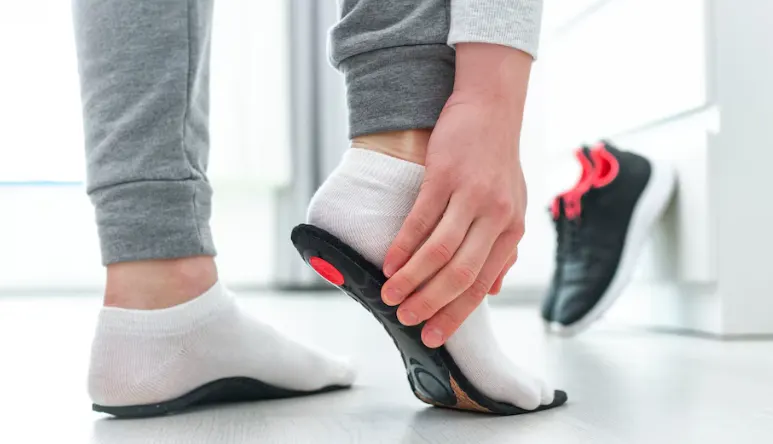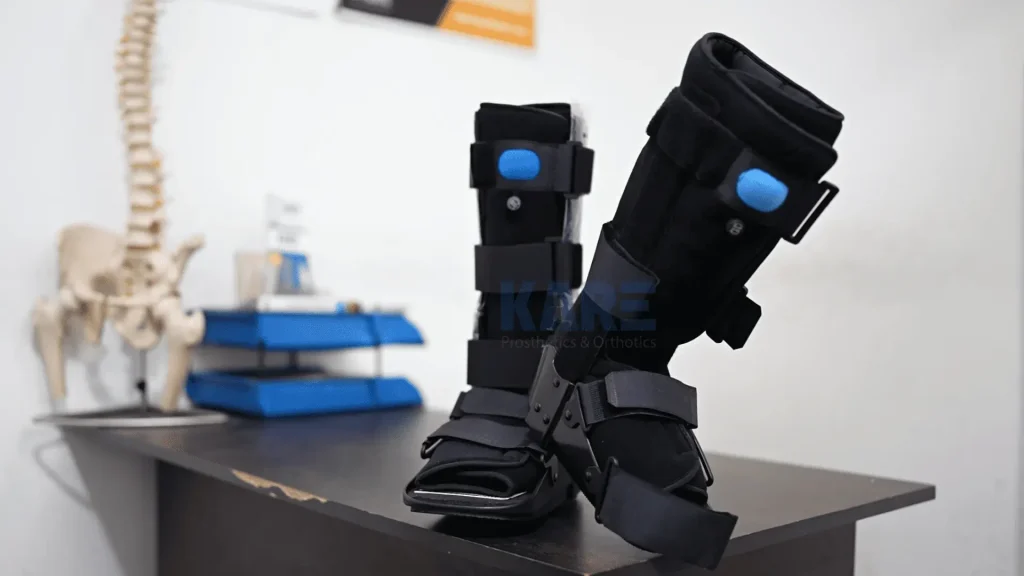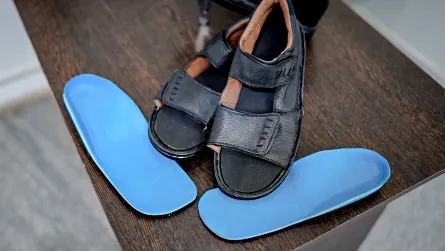People with diabetes face dangerous risks by ignoring foot injuries that include blisters and sores, as well as minor cuts. Unaware of minor foot injuries runs the risk of becoming life-threatening infections that potentially result in the loss of a limb. The good news? It doesn’t have to get to that stage.

Taking care of your feet early, with the proper footwear for diabetics, can make a significant difference. Diabetic footwear is specially designed to reduce pressure, prevent injuries, and protect sensitive feet from further damage.
This blog will explain orthopedic footwear protection methods alongside essential features to consider when choosing one, as well as timing and decision framework for health benefits. People with diabetes or those who support diabetic patients will find this blog essential for developing safer foot health. Let’s dive in and walk toward better foot care.
How Does Your Leg Get Worse Due to Diabetes?
Nerves and circulation throughout your body suffer from diabetes, which most strongly affects your feet. Lack of proper blood circulation prevents you from detecting skin irritations or growths that form on your feet. It also slows down healing. Experts say that gangrene is tissue death. It happens when untreated wounds get worse and lead to infections. Gangrene spreads rapidly in the body. If medical help arrives too late, amputations may be needed.
Check feet at regular intervals and treat any wounds you notice without delay. Understanding these serious complications helps you make better plans to combat diabetes risks.
Why is Footwear for Diabetic Patients Important?
- Walking while touching small objects results in no sensation to the body. Someone with diabetes often faces this symptom because neuropathy hurts their nerve function, leading to reduced pain signals from the body. When blood circulation fails to deliver enough healing power to a foot lesion that went unnoticed after a simple injury, a foot ulcer eventually develops.
- Regular shoes often have improper designs that can create extreme foot problems. When you wear unsuitable shoes that don’t fit your feet, your foot support suffers at pressure points. Severe wounds that occur from injuries develop into infected wounds before starting to cause gangrene, which often results in needing foot amputations.
- Treatment with diabetic footwear becomes vital at this point. The footwear offers increased depth together with cushioned interiors, which reduces friction. The specific orthopedic footwear design relieves and protects sensitive areas while providing proper support that guards against injuries.
Key Features of Orthopedic Footwear
- Special footwear for diabetic patients protects their feet during daily walks. Additional diabetic shoes width and depth create space, reducing foot pressure while accommodating foot shape modifications, such as swelling and deformities. The seamless interior design in footwear helps decrease skin irritation and the chances of blisters and wounds, which becomes essential for people experiencing diminished sensations during neuropathy.
- The footwear for diabetic patients features padding within its inner section, maintaining delicate skin contact. Shock-resilient soles distribute energy to shield joints from excessive force. The supportive arch and heel structure provide better balance and stability, enabling confident walking.
- These shoes for diabetic patients support orthotic devices so that you can get personalised insoles. People with limited hand movement can quickly put on these diabetic foot shoes using velcro fasteners and adjustable straps. Every design choice among these footwear elements promotes foot wellness.
What Types of Footwear for Diabetic Patients Support Daily Foot Activities?
People with diabetes must care for their feet daily through proper orthopedic footwear, as it is an essential protective element. Every environment gets customised protection through footwear specially designed for diabetic patients, providing maximum support and comfort.
1. Diabetic Foot Shoes
- Diabetic foot care shoes are a good match for regular daily activities. Your everyday steps remain protected because these shoes for diabetic patients combine cushioned support with roomy stretch and reduced pressure points to prevent injury. They usually have wider toe boxes, supportive soles, and added padding.
You’ll find:
- Diabetic foot shoes with medical-grade material
- Shoes for diabetics with neuropathy that reduce friction and improve walking
- Offloading shoes for diabetics that protect active ulcers or high-risk areas

Protect your feet with comfort and care. Shop diabetic foot care shoes now!
2. Diabetic Foot Slippers
- Diabetic Foot Slippers perform best when worn indoors. These home-friendly slippers provide comfortable foot protection and simple ease of wear while minimising footwear.
- Warm weather situations require diabetic sandals that are breathable. The footwear’s structure allows for air circulation while maintaining support and preventing pressure points. Slippers for diabetic patients help maintain foot hygiene and reduce injuries on indoor surfaces.
Diabetic foot slippers are specially made for home use and include:
- Padded soles
- Arch support
- Soft, breathable materials
- Anti-slip designs
Find comfort with the best orthopedic slippers for diabetic patients.
3. Custom moulded shoes
- Custom-moulded shoes provide maximum comfort because they fit your foot shape precisely, especially if you have deformities or special requirements.
- The purpose of post-operative diabetic shoes is to establish foot stability and provide secure support after surgery or treatment.
- Choosing the right type for different moments in your day keeps you protected and comfortable.
Importance of Diabetic Foot Care Insoles
Diabetic foot treatment depends heavily on the use of diabetic foot care insoles. Besides shock absorption they provide alignment and reduce stress on painful areas.
Why diabetic foot insoles Matter?
Many diabetics need extra foot support. Regular shoe insoles don’t offer the right cushioning or shape. That’s where diabetic foot care insoles come in.
These diabetic foot insoles:
- Reduce pressure points
- Support the arch and heel
- Improve balance and posture
- Prevent calluses and ulcers
Whether you’re looking for insoles for diabetic neuropathy or just better padding, choose an insole that moulds to your foot and is made of soft, antimicrobial materials.
It consists of
- Gel or memory foam base for comfort
- Arch support to improve posture
- Heel cups to stabilise movement
- Moisture-wicking materials to keep feet dry
There are many affordable diabetic foot care insoles for shoes in India options available online and in orthopaedic clinics. Custom insoles may also be prescribed depending on the foot structure and severity of diabetic complications.
Buy the best foot care insoles for diabetes – trusted across India.
How to Choose the Best Footwear for Diabetic Patients? A Step Toward Better Foot Health
People with diabetes need orthopedic footwear that includes three essential factors: protection and comfort, along with a proper fitting system. The necessary requirement for diabetic footwear involves selecting appropriate footwear which offers adequate support for your needs.
- To select appropriate footwear for diabetic patients, professionals from the fields of podiatry or orthopaedics must offer their advice first. The medical professional will assess your foot health to establish customised solutions suitable for your current conditions, including neuropathy and poor circulation, as well as foot deformities.
- Your foot type and current medical condition determine the support your feet require most. The correct shoe size and fit are essential because ill-fitted shoes can cause wounds or discomfort.
- Your best purchase is medical-grade footwear certified for diabetes care. Test the footwear by wearing it in the afternoon to find the most accurate fit, as foot swelling often occurs in the late afternoon.
- Evaluate comfort, flexibility, and pressure points while testing for appropriate support without discomfort or tightness. The right orthopedic footwear ensures that your security remains protected during every daily activity.
When to Start Wearing Diabetic Footwear?
People with diabetes should start wearing special shoes if they notice any small changes in their feet or have ongoing numbness or discomfort. It’s essential to see a doctor because these signs might indicate nerve issues. People with foot wounds or changes in foot shape that need protection should wear diabetic shoes.
Doctors suggest that people with diabetes should get special shoes early to help keep their feet healthy and prevent problems before symptoms show up. The early implementation of prevention strategies allows people to develop a sense of security while walking.
What is the Difference Between Diabetic Shoes and Regular Shoes?
| Features | Diabetic footwear | Regular footwear |
| Interior seams | Seamless | May have rough seams |
| Depth & width | Extra space is available | Only limited options |
| Pressure distribution | Even | Uneven |
| Material | Soft & breathable | It varies |
Tips to Take Care of Footwear for Diabetic Patients
Diabetic footwear maintenance requires the same level of importance as wearing the footwear. Maintaining your diabetic footwear through proper care will extend its protective ability by following these steps:
- To stop bacterial growth, clean your footwear with mild soap and a damp towel to remove dirt.
- Proper drying techniques apply to shoes, while avoiding moisture is essential. Air drying continues until the shoes are completely dry, preventing moisture that could cause infections.
- Regular replacement of worn-insoles is needed since their support features deteriorate with time. Your feet require protection when you use a new insole.
- Check your shoes for any possible damage, including cracks, rough seams, or loose stitching. Outdated footwear shows its wear and tear in areas that might lead to both pressure points and friction points.
- Walking without shoes should be avoided entirely, no matter where you are. Diabetic footwear requires users always to wear suitable protective shoes that defend against both accidental hazards and damaging ground materials.
- Keeping up with regular maintenance provides maximum performance from shoes, which preserves your feet’s safety and health at the same time.
Where to Buy Footwear for Diabetic Patients?

Avoid unauthorised stores and general retailers when purchasing footwear for diabetic patients. The successful choice of orthopedic footwear remains impossible to determine by anyone except through expert help. The proper footwear choice requires expert assessment from your doctor and orthotist to ensure your foot health and select the suitable option.
The facilities of orthotic and prosthetic centres provide footwear for diabetic patients that meets official medical certification requirements. You should buy diabetic shoes only from reputable medical brands, and receive professional guidance on size and design specifications.
Experts help design custom shoes that keep your feet safe while making sure they’re comfortable and supportive. The appropriate foot care comes exclusively from established healthcare institutions. KARE offers the best-measured and customised diabetic shoes to meet your needs.
Get your Diabetic footwear today!
Conclusion
Focusing on foot health becomes essential for people with diabetes, as it is a crucial need. High blood sugar levels will quietly destroy nerves and blood circulation, leading to dangerous consequences from injuries. The lesson explained diabetic shoe characteristics, their different daily uses, and proper selection methods for patients with particular medical conditions. Taking care of shoes for people with diabetes can help prevent foot sores and infections, which can sometimes lead to amputations.
KARE Prosthetic and Orthotic: Best Diabetic Footwear Solution in India
KARE fully recognises that diabetic foot medical care demands serious attention. Our approach produces diabetic footwear that matches your foot measurements, specific medical needs, and foot size and shape. Professionals specially design diabetic footwear pairs to maximise protection, comfort, and support, reducing pressure while preventing injuries and providing optimal fit.
Our diabetic solutions are designed to protect you with solutions that help prevent the development of symptoms and complications. The staff has assisted numerous patients in minimising foot wound risk through preventive measures, preventing foot amputation. At KARE Prosthetics and Orthotics India, clinicians dedicate themselves to expert foot care because appropriate support begins with healthy steps.
Most Asked Questions:
Q1. what are the best walking shoes for diabetics with neuropathy in India?
Q2. Are diabetic foot slippers different from normal slippers?
Q3. How much do diabetic shoes price in India?
Q3. best running shoes for diabetics
Q4. most comfortable shoes for diabetics
Q5. Can I use normal insoles in diabetic shoes?
Q6. Where can I find diabetic shoes in Bangalore or Hyderabad?
“Get Direct Answers from Our Experts to Your Most Asked Questions. Ask Now!“





